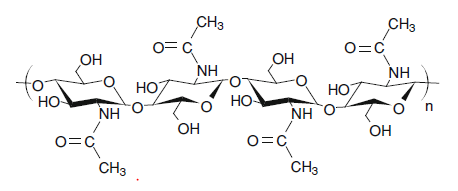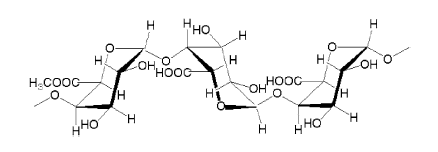‘‘Biodegradable’’ means ‘‘capable of undergoing decomposition into carbon dioxide, methane, water, inorganic compounds, and biomass’’.
Compostability is material biodegradability using compost medium. Biodegradation is the degradation of an organic material caused by biological activity (biotic degradation), mainly microorganisms’ enzymatic action.
Agro-Polymers:
Agro-based polymers are made from renewable natural sources of various kind. Carbonhydrates, saccharides, starch and oils can be converted into materials with properties comparable to plastic derived from mineral oil.
Polysaccharides:
Polysaccharides are the most abundant macromolecules in the biosphere. These complex carbohydrates constituted of glycosidic bonds are often one of the main structural elements of plants and animals exoskeleton (cellulose, carrageenan, chitin…). The polysaccharides presented in this chapter are starch, chitin, chitosan, and pectins, successively.

Starch:
Starch is mainly extracted from cereals (wheat, corn, rice…) and from tubers (potatoes, manioc…). It is stocked in seeds or roots and represents the main plant energy reserve.
Native Starch Structure:

Depending on the botanical origin of the plant, starch granules can have different shapes (sphere, platelet, polygon…) and size (from 0.5 to 175 lm). These granules are composed of two a-D-glucopyranose homopolymers, the amylose and the amylopectin. Their proportions in the granules depend directly on the botanical source. In addition, starch also contains, in much smaller proportions, other compounds such as proteins, lipids and minerals.
Plasticized Starch:
Because of numerous intermolecular hydrogen bonds existing between the chains, the melting temperature (Tm) of starch is higher than its degradation temperature. Consequently, to elaborate a plastic-like material, it is necessary to introduce high water content or/and some non-volatile plasticizers (glycerol, sorbitol,…) which decrease the glass transition temperature (Tg) and the Tm.
These plasticized materials are currently named ‘‘thermoplastic starch’’ or ‘‘plasticized starch’’.
Chitin and Chitosan:
Chitin is the second most abundant agro-polymer produced in nature after cellulose. It appears in nature as ordered crystalline microfibrils forming structural components in the exoskeleton of arthropods or in the cell walls of fungi and yeasts. It is an acetylated polysaccharide composed of N-acetyl-D-glucosamine groups linked by ![]() . From chitin, chitosan is obtained by
. From chitin, chitosan is obtained by
deacetylation.

Depending on the source, chitin occurs in two allomorphic forms named a and b. A third allomorphic structure c has also been reported, but it seems to be a variant of the a form. These two structures are organized in crystalline sheets where a number of intra-sheet hydrogen bonds tightly hold them. The a form presents some inter-sheets hydrogen bonds. Such a feature is not found for the b form, which is consequently more prone than the a form to water swelling.

In solid state, chitosan is a semi-crystalline polymer. Its morphology has been investigated and many allomorphs have been described, depending on its acetylation degree, on the distribution of the acetyl groups along the carbohydrate chain, and on the chitosan preparation procedure.
Chitosan can be plasticized with glycerol to obtain a kind of thermoplastic material like, for instance, plasticized starch.
Pectin:
Pectin is a linear macromolecule constituted of ![]() D-galacturonic acid. This monomer unit could be partially replaced by
D-galacturonic acid. This monomer unit could be partially replaced by ![]() L-rhamnose leading to a new structure named rhamnogalacturonan I.
L-rhamnose leading to a new structure named rhamnogalacturonan I.
A third pectin structural type is rhamnogalacturonan II, which is a less frequent, but complex and highly branched polysaccharide.

Proteins:
Proteins are agro-polymers. They are an important renewable resources produced by animals, plants, and bacteria. The term ‘‘protein’’ comes from the Greek, proteios, for ‘‘primary, first and foremost’’. A certain number of proteins have received much attention as biodegradable polymers but few have led to actual industrial scale-up due to the high production cost and the low product performance.
In terms of potential sources, soy protein, corn protein (zein…) and wheat proteins (gluten…) are among the main plant proteins. Casein, collagen protein or gelatin, and keratin are important animal proteins. Lactate dehydrogenase, chymotrypsin, and fumarase constitute the main bacterial proteins.

Biochemists often refer to four distinct aspects of a protein’s structure:
• Primary structure: the amino acid sequence.
• Secondary structure: regularly repeating local structures stabilized by hydrogen bonds such as the alpha helix or the beta sheet. Different zones with various secondary structures can be present in the same protein.
• Tertiary structure: the overall shape of a single protein molecule; the spatial relationship of the secondary structures to another. Tertiary structure is generally stabilized by nonlocal interactions with the formation of a hydrophobic core. The tertiary structure is what controls the basic function of the protein.
• Quaternary structure: the structure formed by numerous proteins, which function as a single protein complex.
Soybean Proteins:
Typically soybean proteins contain 38–42 % crude protein, 16–20 % triglycerides, and around 33 % carbohydrates, on dry basis. Soy proteins are the isolated proteins from soybean. It is made of dehulled, defatted soybean meal. Dehulled and defatted soybeans are processed into three kinds of high protein commercial products: soy flour, concentrates, and isolates.
Corn Proteins:
Proteins form about 9 % of the dry weight of corns. They are mainly composed of zein (a highly hydrophobic protein, soluble in alcohols), glutelin (soluble in aqueous alkaline solutions), albumins, and globulins. Zein comprises about 40 % of the total kernel protein on dry basis. It is one of the few cereal proteins extracted in a relatively pure form and is a unique and complex biopolymer.
Wheat Gluten:
Wheat gluten is a protein carbohydrate complex of which proteins are the major component. Two main fractions are present. Gliadin is soluble in neutral 70 % ethanol, made of single chain polypeptides with an average molecular weight of 25,000–100,000 g.mol-1 by intramolecular disulphide bonds.
The second fraction is glutenin, which is an alcohol-insoluble fraction consisting of gliadin-like subunits
stabilized by intermolecular disulphide bonds in large aggregates with molecular weight greater than 100,000 g.mol-1.
Casein:
Caseins are animal proteins and are commonly found in mammalian milk, making up 80 % of the proteins in cow milk and between 60 and 65 % of the proteins in human milk. Casein molecular weight is between 1,000 and 20,000 g.mol-1.
Gelatin:
Gelatin is a natural material based on animal proteins. It is derived from collagen, which is elongated fibrils and mostly found in fibrous tissues such as tendon, ligament, and skin. It is also abundant in cornea, cartilage, bone, blood vessels, gut, and intervertebral disc.
